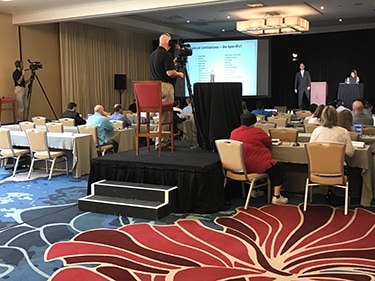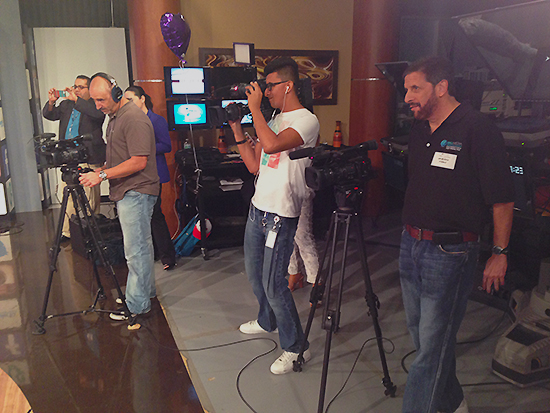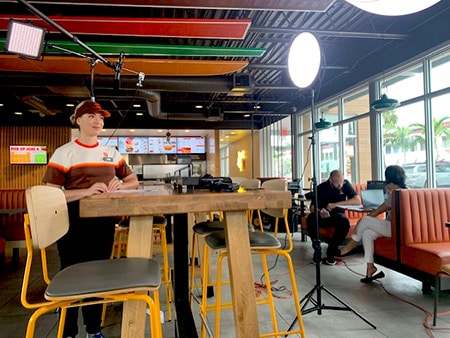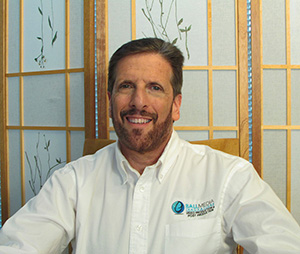By Greg Ball, President of BMI
When it Comes to Cameras - How Many Do We Really Need?
What's Optimal, What's necessary?
“Lights, camera, action!”
That’s it right? Just like the say in the movies, all I need for my corporate video or commercial video production is a camera, maybe a few lights – and roll ‘em. ! Well not exactly, with today’s digital technology, you may not actually be “rolling” anything – and you may need quite a bit more gear than just a single video camera and some lighting.

Sure, if you have an unlimited budget it would be nice to roll in with a large video crew, a full grip truck, and every bell and whistle imaginable. But independent projects with unlimited budgets are very few and far between.
It may not sound as sexy as “Lights, Camera, Action,” but the reality is, getting the right gear and the right crew for your shoot, begins with good pre-production.
Fail to Plan, Plan to Fail
Or if not fail, at least to go over budget.
Any successful video project is going to require a great deal of planning. The old adage of the “5 Ps” still applies whether you are doing your production internally, or hiring an outside production company and crew – Pre-Planning- Prevents-Poor-Production.
There’s an old saying that a picture is worth a thousand words. Multiply that by a few million pixels, and -- you get the picture! Video creates an emotional connection to your target audience in a way that text alone just can’t touch.
More and more companies are coming to realize that web video is good for more than just cute videos of puppies and kittens, or teenagers getting pranked.
Any shoot has many elements, and all of them, from the location to the subject matter, to the approach, are going to affect the kind and amount of equipment required. Examining these elements at length, in the pre-production phase, will not only help you to determine the right gear but will save you a lot of headaches come shoot day.

Some videographers and directors may like the spontaneity of shooting on the fly. But others like to plan in advance. They do it with meticulous detail, panning, or “blocking” each shot, determining his or her camera angles, and lighting requirements during a “location scout.”
Regardless of the number of cameras, and other gear you determine you need, the gear and necessary crew are going to cost money. Better to plan in advance, before they are on set, and on the clock!
Determining Your Equipment Needs
At the core of the shoot, of course, is the camera. If you are working with a video professional, you can expect that he will have a variety of cameras and lenses available to achieve the look you want for your budget. The same goes for lighting. Your location and the nature of what is being recorded will determine your lighting requirements. In many ways, lighting is more important than the camera. Proper lighting can make all the difference between your video looking sloppy, or professional that creates an impact. You may not realize it, but it is the skills of a good videographer or lighting director that allows a subject to connect and resonate with the audience. The word photography literally translates to “painting with light.”
Often it may be necessary to shoot with multiple video cameras and camera operators at the same time.
Here are a few scenarios when more than one camera is necessary:
- Live conference/convention – When shooting a live conference, it’s best to have at least 2 cameras shooting a presentation. One camera can be focused on a close shot of the presenter, and the second camera can be set as a wider shot. This allows the production company to create interest and keep the viewer’s attention. During the editing process, the editor will cut between the two cameras, allowing the viewer to feel like their sitting in the audience watching the presentation. If you wish to have footage of the audience in the video, it’s better if there are 3 video cameras and operators. Two video cameras are focused on the presenter and one is focused on the audience. This is especially useful if there are going to be questions asked by the audience.
- Talk show-style video – When shooting a talk show style video with an on-camera interviewer or host and at least 1 guest, it’s best to have a minimum of 2 cameras. One camera should be focused on a wider shot of the interviewer and guest, and the second camera should shoot close-up shots of the guest as they speak, and close-up shots of the interviewer as he or she asks questions. If there are multiple guests speaking, it’s better if there are a minimum of 3 cameras. This way 1 camera is still on a wide shot of everyone on the couch or chairs and the other 2 cameras can shoot close-ups of whoever is speaking.
- Specialized shots – A video may call for specialized types of shots, such as high angle shots from a jib, and also shots from the ground. This may be necessary when shooting an industrial video where people are working with large pieces of equipment. By using two cameras, one camera can get those high angle swooping shots, while the other camera shoots close-ups of the industrial equipment and equipment operator in action.
Often a scene may call for a camera to be mounted on a dolly or Steadicam, but not every shot in the production will be on the Steadicam or dolly. It’s time-consuming to keep removing the camera from the dolly or Steadicam, then connecting and balancing it again for another scene. It’s faster to just have a second camera handy.
- When time is limited – Let's say your CEO only has a short amount of time available for your video. Having two cameras available allows for shooting his presentation as a wide and tight shot. This way, if he stumbles on his words, you can just have him continue on. Then during the editing, you can cut from the tight shot to the wider shot, removing the stumble. It will definitely save time, and your CEO will be thrilled.
Having 2 cameras in this scenario also allows you to get some different types of “artsy” shots. For example, maybe the person speaking uses their hands as they speak, or they show a product to the viewer. By having 2 cameras present, one camera can shoot the main presentation, and the second camera can shoot the presenter's hands or a close up of the product. Shooting this in real-time allows for a quicker shoot, and allows for perfect continuity.

Lighting is also important. Your location and the nature of what is being recorded will determine your lighting requirements. In many ways, lighting is more important than the camera. Proper lighting can make all the difference between your video looking sloppy or professional. That creates an impact. Viewers may not realize it, but only a really good videographer or lighting director has the skill to use the lighting to help get the video to connect and resonate with the audience. The word photography literally translates to “painting with light.”
What Should You Do Now?
Contact us.
We'd be happy to discuss your video with you. We'll help you determine what equipment you really need, and we'll give you a free quote. We offer outstanding quality at competitive prices.
 About the Author & His Company: Greg Ball, is President of Ball Media Innovations, Inc. Prior to starting the company, he ran the Burger King World Headquarters video operation. Greg founded Ball Media as a Miami video production company in 2002.
About the Author & His Company: Greg Ball, is President of Ball Media Innovations, Inc. Prior to starting the company, he ran the Burger King World Headquarters video operation. Greg founded Ball Media as a Miami video production company in 2002.
©Copyright 2023 Ball Media Innovations, Inc. All rights reserved. Any reproduction of the written contents or images on this website without prior written consent by Ball Media Innovations, Inc. will be prosecuted. This site is protected by Copyscape.